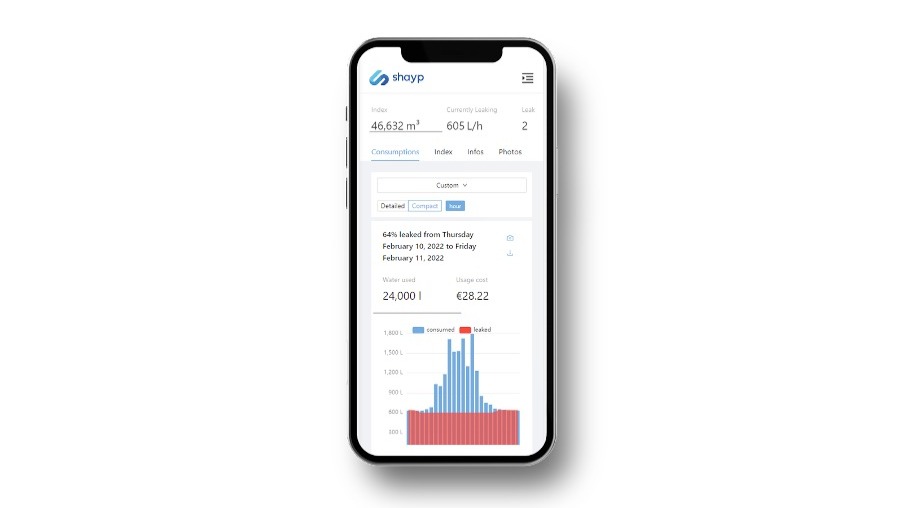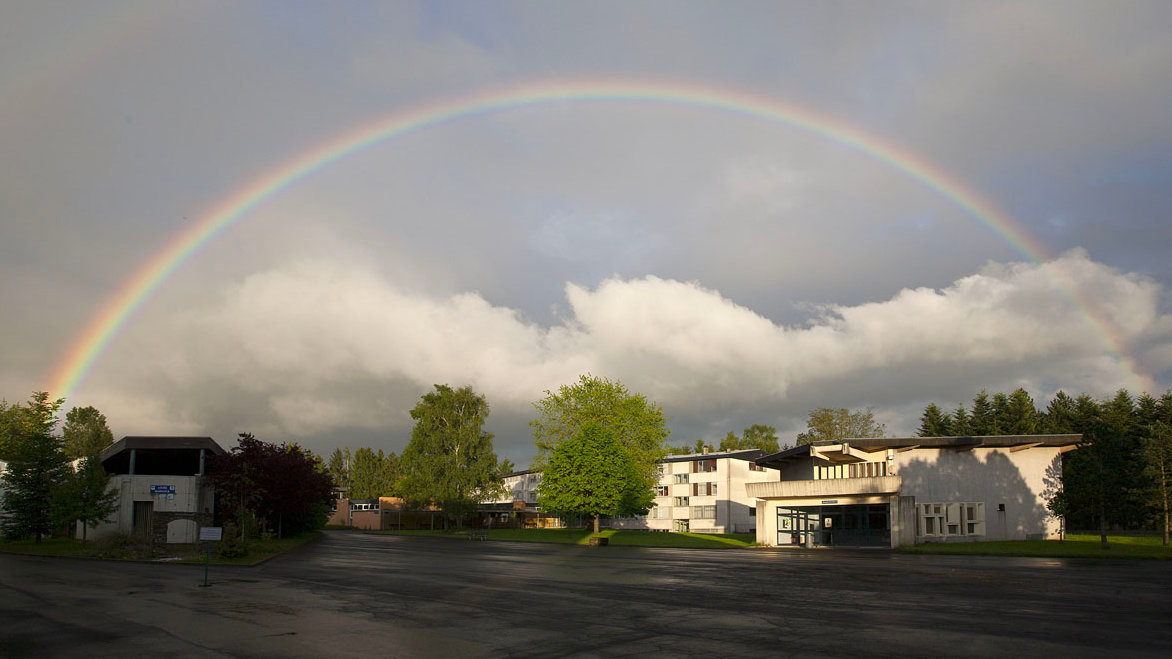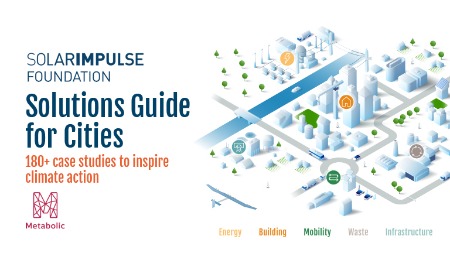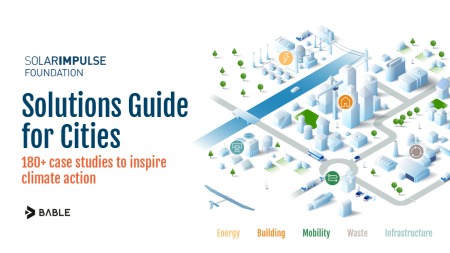News - December 9, 2022
A Close-up on... Shayp


Written by Alexandra Barraquand 5 min read
Already adopted in more than 4000 buildings in Europe, Shayp's technology has been installed as part of a pilot project in collaboration with Engie Solutions in three buildings and agricultural apprentice training centers of a vocational high school in the Ardennes, France in January 2021.
This installation was spurred by a contact with the Grand Est Region by the Solar Impulse Foundation and has enabled the launch of a larger-scale project to install the technology in more than 86 high schools in the Grand Est Region starting in April 2022.
So, what was the issue? Overconsumption of water in buildings and ignorance about the volumes wasted.
Schools and universities face the problem of water waste more than any other type of building. Indeed, old pipes and the numerous users increase the risk of leaks and wears out the infrastructure more quickly. For example, at the University of Toulon, 50% of water consumption was linked to leaks. In parallel, the impact of global warming makes us increasingly prone to water shortages that affect all regions: in May 2022, France broke a spring record of 38 consecutive days of heat causing 54 orders of water restrictions in 16 provinces.
Faced with this problem, a majority of educational buildings are not aware of how much they consume. They pay the bill without question. In other cases, where resources are more important and staff have been sensitised, qualified maintenance managers take meter readings manually which are then transferred to excel files to follow the evolution of drinking water consumption over several months/years. In addition, there is an "opportunistic" method of leak detection, with a user of the building (e.g. a student) alerting the manager of a leaking infrastructure, or a maintenance manager who tours a building every evening to look for apparent leaks in taps or flushes. However, the limit to this system, apart from the inevitably long reaction time, is the impossibility of detecting very small leaks before they have a significant impact or worsen the state of the infrastructure. 95% of water leaks are not visible or detected.

THE SOLUTION: A water leak detection and management system for the building, called SHAYP
The Solution includes a sensor connected to the utility's water meter, an online access to a consumption monitoring platform for building managers, and a maintenance service in case of leaks.
The system measures at high frequency very small differences in water consumption where they are not or less likely to occur and deduces leaks. The detected consumption anomalies are then communicated to the building manager by SMS or via a mobile application - example of SMS or mail : "Leakage detected of 22 litres per hour in CFA/CFPPA! If not repaired, it can increase your annual bill by 224EUR. It is estimated that the leak has been running for 7 days. Find out what you can do at the link below: " with indication of where they should look for the anomaly and hints on the leakage profile according to the anomaly profile (flush, tap, pipe etc.).


For leaks that are not found, the company provides specialized maintenance managers to assist the technician with other tools (IR, acoustic etc.).

Added value
- Granularity > A very fine granularity of data collection at the water meter - every 30 seconds (up to 7 seconds). This allows you to know in real time what your water consumption is and to detect anomalies and leaks more quickly.
- Plug & Play > A system that can be implemented without touching the plumbing of the building (no modified/cut pipes) because the box is installed on the existing water meter (99% of water meters are compatible provided that the meter is not too old and that you have access to the meter). Therefore, a faster installation (5-15 minutes) and the possibility of deployment in one day on several buildings (50 water meters can be equipped in less than 10 days).
- Energy autonomy > Energy autonomy of the system without electricity or wifi consumption - a SIM card sends the data to the platform - to operate the box thanks to an integrated battery to be changed every 10 to 15 years.
Environmental benefit
Calculated on the month of May 2022 realized by the installation of the technology on the two buildings of the EPLEFPA of the balcony of the Ardennes


Then, let's dive into a concrete implementation, with the case of an agricultural high school in the Ardennes region of France.
Profitability of the project
Total budget: €3000
Details: 3 buildings each equipped with a datalogger, 1000 € per building for the full service of Shayp (from hardware installation to access to our platform, automatic leak detection, customer support etc.). The additional service "leak repair" with an external service provider was not yet part of the offer for this pilot project.
Financier: Région-Grand Est (100%) - public
Return on investment: 8 months.

THE FOLLOW-UP: How will the Solution be implemented on a larger scale in the Grand Est Region?
By integrating into a relationship of trust that already existed between the Grand Est Region and its service provider ENGIE Solutions.
After the pilot project on the Lycée Agricole du Balcon des Ardennes, a new project of implementation of the Shayp Solution is planned in 86 high schools of the region and is supported by 3 complementary actors:
The Grand-Est Region, owner of the 86 buildings in question
Engie Solutions, maintenance manager approved by the Grand-Est Region
Shayp, the solution provider
The Region was looking for innovative solutions to fight against water wastage in buildings and launched a call for tender.
Shayp being a small structure and not knowing the region, the entity preferred to find ways to avoid going through a tender alone by entering into discussions with Engie Solutions - which was already collaborating with the Grand Est Region as the maintenance manager of a large portfolio of buildings and therefore a preferred partner of the region. At the time, Engie Solutions did not have any in-house solutions for digitizing water meters to combat waste in buildings.
After competing with several technologies, Engie Solutions chose to integrate Shayp's solution into their own cloud-based energy management platform and the two entities eventually collaborated to bid on the project together.
Today, Engie Solutions is handling the installation of Shayp's technology in the 86 high schools in the Grand Est Region as well as the compatibility with the network's water meters.
BARRIERS AND REGULATORY TRACKS
Barriers
Lack of transparency
The practical limits to the deployment of systems such as Shayp are, on the one hand, the obsolescence of water meters, and on the other hand, the non-transparency of the large water companies that have taken the habit of keeping control and visibility of consumption records, blocking at the same time the democratization of access to consumption data for users/building owners.
The "it happens to others" reflex
A barrier also lies in cases where people are used to a certain level of water bill that does not vary significantly so they do not receive the strong signal and ignore that 40% of this bill can be due to leaks alone. On the other hand, the people most likely to act on their water consumption will be those who have experienced very large and sometimes traumatic variations in the amount of their bills, or who have experienced water damage that has caused them to lose precious possessions.
Regulatory actions
Integrate water in the energy regulation programs of buildings
In France, the tertiary sector decree obliges tertiary sector buildings of more than 1,000 square meters to declare their gas and electricity energy consumption data, but not their water consumption data. The CNCCR does not include it because they consider that water is a resource, not an energy, even if it is part of the life of the building. One way to improve would be to add water to this decree as was done in Belgium in the PLAGE program (Local Action Plan for Energy Management), established in 2005 and which will be amended in 2022 to include drinking water consumption data.
Impose meter data transparency on water companies
Finally, public authorities have the leeway and legitimacy to directly regulate the transparency obligations of water companies, which should provide access to real-time meter data, following the example of Belgium, where water companies are required to provide access to consumption data of public and private buildings.

Written by Alexandra Barraquand on December 9, 2022



